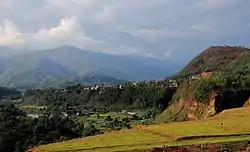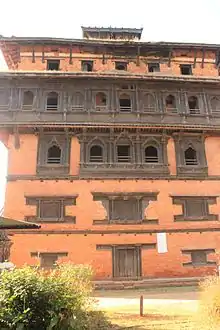Nuwakot District
नुवाकोट जिल्ला | |
|---|---|
 Valley in Nuwakot | |
 Location of district in province | |
| Country | |
| Province | Bagmati Province |
| Admin HQ. | Nuwakot (Bidur Municipality) |
| Government | |
| • Type | Coordination committee |
| • Body | DCC, Nuwakot |
| Area | |
| • Total | 1,121 km2 (433 sq mi) |
| Population (2011) | |
| • Total | 277,471 |
| • Density | 250/km2 (640/sq mi) |
| Time zone | UTC+05:45 (NPT) |
| Postal Codes | 44900, 44908 |
| Main Language(s) | Nepali, Tamang, Newar, Magar, Sherpa |
| Website | http://www.dccnuwakot.gov.np |
Nuwakot District (Nepali: नुवाकोट जिल्लाⓘ, a part of Bagmati Province, is one of the seventy-seven districts of Nepal. The district, with Bidur as its district headquarters, covers an area of 1,121 km2 (433 sq mi) and had a population of 288,478 in 2001 and 277,471 in 2011. It is a historically important district in Nepal. Prithvi Narayan Shah died in Devighat of Nuwakot.
The district contains places of historical significance such as the town of Nuwakot, and the village of Devighat located at the confluence of the Tadi and Trishuli Rivers. Kakani is popular among Nepalese people as a touristic place and picnic spot. Nuwakot holds the different reminance from the unification movement pioneered by late king Prithvi Narayan Shah to the present situation.
Etymology
The name, 'Nuwakot', is made up of two words 'nawa' and 'kort'. 'Nawa' means nine in Nepali and 'kort' means sacred religious sites at the top of hill. The district accordingly has nine hills over which various deities are said to dwell thus overseeing and protecting Nuwakot. This has led Nuwakot often being called "City of nine hills". The Gorkhali king Prithivi Narayan Shah invaded Nuwakot which was under the ruling of Jaya Prakash Malla and made Nuwakot the capital of his kingdom.
Geography and climate
| Climate zone[1] | Elevation range | % of area |
|---|---|---|
| Upper tropical | 300 to 1,000 meters 1,000 to 3,300 ft. |
28.6% |
| Subtropical | 1,000 to 2,000 meters 3,300 to 6,600 ft. |
50.8% |
| Temperate | 2,000 to 3,000 meters 6,400 to 9,800 ft. |
13.4% |
| Subalpine | 3,000 to 4,000 meters 9,800 to 13,100 ft. |
3.9% |
| Alpine | 4,000 to 5,000 meters 13,100 to 16,400 ft. |
1.3% |
| Nival | above 5,000 meters | 0.3% |
Demographics
| Census year | Pop. | ±% p.a. |
|---|---|---|
| 1981 | 202,976 | — |
| 1991 | 245,260 | +1.91% |
| 2001 | 288,478 | +1.64% |
| 2011 | 277,471 | −0.39% |
| 2021 | 262,981 | −0.53% |
| Source: Citypopulation[2] | ||
At the time of the 2011 Nepal census, Nuwakot District had a population of 277,471.
As their first language, 54.5% spoke Nepali, 40.1% Tamang, 2.0% Newari, 0.9% Lepcha, 0.4% Gurung, 0.4% Kumhali, 0.4% Rai, 0.2% Magar, 0.2% Sherpa, 0.1% Bhojpuri, 0.1% Ghale, 0.1% Hindi, 0.1% Yolmo, 0.1% Maithili, 0.1% Urdu and 0.2% other languages.[3]
Ethnicity/caste: 43.0% were Tamang, 19.0% Hill Brahmin, 12.5% Chhetri, 7.4% Newar, 3.6% Rai, 3.2% Kami, 2.3% Magar, 1.7% Damai/Dholi, 1.7% Sarki, 1.0% Gurung, 0.9% Kumal, 0.6% Sanyasi/Dasnami, 0.5% Gharti/Bhujel, 0.4% Ghale, 0.3% other Dalit, 0.3% Thakuri, 0.2% Majhi, 0.2% Sherpa, 0.1% Badi, 0.1% Danuwar, 0.1% Yolmo, 0.1% Musalman, 0.1% Sonar, 0.1% Sunuwar and 0.4% others.[4]
Religion: 57.8% were Hindu, 40.0% Buddhist, 1.6% Christian, 0.2% Kirati, 0.1% Muslim and 0.3% others.[5]
Literacy: 59.5% could read and write, 3.6% could only read and 36.7% could neither read nor write.[6]
Administration
The district consists of 12 municipalities, out of which two are urban municipalities and ten are rural municipalities. These are as follows:[7]
- Bidur Municipality
- Belkotgadhi Municipality
- Kakani Rural Municipality
- Panchakanya Rural Municipality
- Likhu Rural Municipality
- Dupcheshwar Rural Municipality
- Shivapuri Rural Municipality
- Tadi Rural Municipality
- Suryagadhi Rural Municipality
- Tarkeshwar Rural Municipality
- Kispang Rural Municipality
- Myagang Rural Municipality
Economy
Nuwakot, being a hilly area with very less plains, most of the areas are still undeveloped. In last few years, huge changes are observable. The city areas are provided with schools, colleges, hospitals and the road infrastructure is also developed. Two hydro power stations are currently in operation, and from 2020 the first part of the biggest solar power station (Nuwakot Solar Power Station) was consented to the electric grid of Nepal. People are dependent on agriculture, teaching, foreign economy, livestock farming, business, hotels, Agro Tourism, Eco-Tourism and Khadya Bank, etc.
Special Economic Zone
Jiling is recognized as an SEZ Area where business flourishes and there is an intent to grow business and economy of Nuwakot. NEPAL KHADYA BANK LTD. has established at Kashitar to serve farmers in Food Security, Food Banking, Grain Storage, Supply and Distribution.
See
Nuwakot, Bagmati : A seven-storey palace lies on the top of Bidur Municipality. Views of Nuwakot can be observed from the spot.

Trishuli River : One of the major river of Saptagandaki passes right through mid area of Nuwakot.
Kakani : A gateway from Kathmandu to Nuwakot. A common place for observing sunset and the mountains.
Devighat : Near the union of Trishuli and Suryamati (Tadi) river lies devighat. This place is historically important. The death place of the great king Prithvi Narayan Shah lies here.
Kashitar : One of the major place where people work in Eco Tourism, Agri Tourism and Food Security.
Religious places
Nuwakot, being mainly Hindu by religion, has many historically as well as religiously important places.
- Bhairavi Temple
- Jalpa devi Temple
- Dupcheshwar Mahadev Temple
- Chimteshor Mahadev
- Bandevi Temple
- Panchakanya Temple
- Indra Kamala Temple
Indrakamala Mai Temple is a religious and cultural place in Nuwakot district, which is 18 km far from Bidur the headquarter of Nuwakot and 8 km from Kakani Rural Municipality Office. It lies in the Kakani Rural Municipality ward number -8 under Bagmati province. It is surrounded with natural greenery and located at the beach of the three gorges where thousands of devotees come for worshiping god Indrakamala basically in Dashain. It is believed to achieved aims and desires after worshiping.
See also
Notable people
References
- ↑ The Map of Potential Vegetation of Nepal - a forestry/agroecological/biodiversity classification system (PDF), Forest & Landscape Development and Environment Series 2-2005 and CFC-TIS Document SeriesNo.110., 2005, ISBN 87-7903-210-9, retrieved Nov 22, 2013
- ↑ "NEPAL: Administrative Division". www.citypopulation.de.
- ↑ NepalMap Language
- ↑ NepalMap Caste
- ↑ NepalMap Religion
- ↑ NepalMap Literacy
- ↑ "स्थानिय तह" (in Nepali). Ministry of Federal Affairs and General Administration. Archived from the original on 31 August 2018. Retrieved 1 September 2018.
- ↑ संवाददाता, केन्द्रबिन्दु. "किशोर नेपाल : गुरु कि गडफादर ? (भिडियो सहित)". Retrieved 2021-08-12.
- "Districts of Nepal". Statoids.
27°55′N 85°15′E / 27.917°N 85.250°E